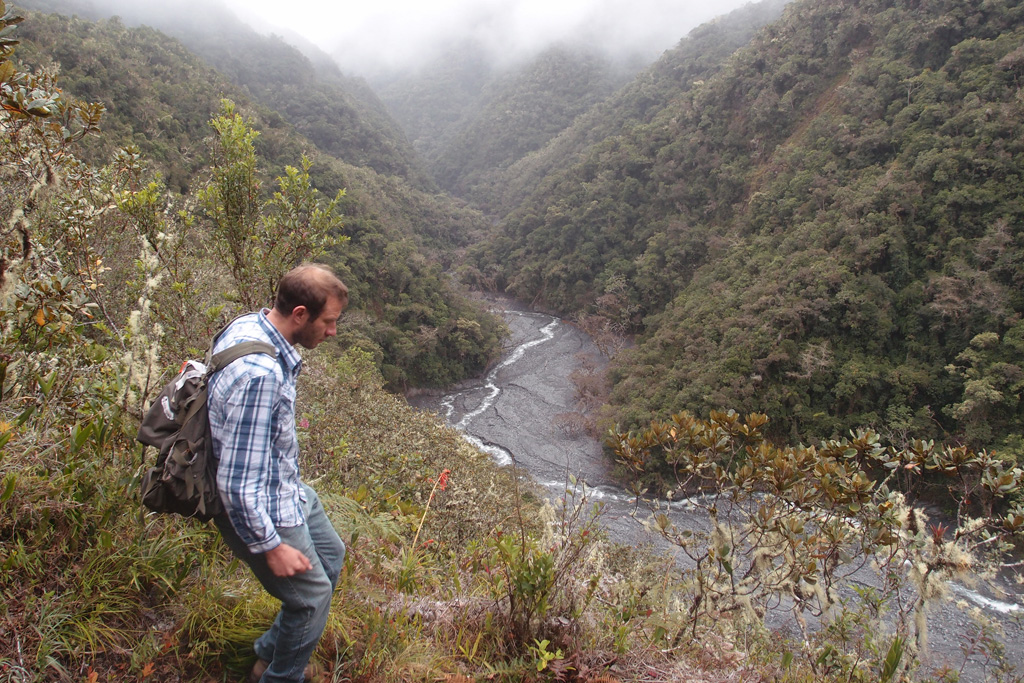Why Earth remains capable of supporting life despite CO2 greenhouse gas emissions
March 23, 2014

Researcher Josh West treks through a valley in Peru in search of evidence of chemical weathering of rocks as they erode. (Credit: Mark Torres)
“Fresh” rock — nature’s atmospheric carbon dioxide regulator — explains why the Earth has become neither sweltering like Venus nor frigid like Mars. So say researchers from USC and Nanjing University in China.
Scientists have long known that “fresh” rock pushed to the surface via mountain formation effectively acts as a kind of sponge, soaking up the greenhouse gas CO2.
Left unchecked, however, that process would deplete atmospheric CO2 levels to a point that would plunge the Earth into an eternal winter within a few million years during the formation of large mountain ranges like the Himalayas — which has clearly not happened.
Balanced for millions of years
That’s because fresh rock exposed by uplift also emits carbon through a chemical weathering process, which replenishes the atmospheric carbon dioxide at a comparable rate — keeping things balanced for millions of years.
“Our presence on Earth is dependent upon this carbon cycle. This is why life is able to survive,” said Mark Torres, USC doctoral fellow at the Center for Dark Energy Biosphere Investigations (C-DEBI).
Torres and USC professor of Earth sciences Joshua West studied rocks taken from the Andes mountain range in Peru and found that weathering processes affecting rocks in the Andes unearths abundant pyrite, and its chemical breakdown produces acids that release CO2 from other minerals.
Like many other large mountain ranges, such as the great Himalayas, the Andes began to form during the Cenozoic period, which began about 60 million years ago and happened to coincide with a major perturbation in the cycling of atmospheric carbon dioxide.
Using marine records of the long-term carbon cycle, Torres, West and Gaojun Li of Nanjing University reconstructed the balance between CO2 release and uptake caused by the uplift of large mountain ranges and found that CO2 release by rock weathering may have played a large, but thus far unrecognized, role in regulating the concentration of atmospheric carbon dioxide over the last roughly 60 million years.
The research appeared in Nature March 20 was supported by USC Dornsife and C-DEBI Graduate Fellowships to Torres, National Science Foundation funding to West and National Natural Science Foundation of China funding to Li.
Abstract of Nature paper
The observed stability of Earth’s climate over millions of years is thought to depend on the rate of carbon dioxide (CO2) release from the solid Earth being balanced by the rate of CO2 consumption by silicate weathering. During the Cenozoic era, spanning approximately the past 66 million years, the concurrent increases in the marine isotopic ratios of strontium, osmium and lithium suggest that extensive uplift of mountain ranges may have stimulated CO2 consumption by silicate weathering, but reconstructions of sea-floor spreading do not indicate a corresponding increase in CO2 inputs from volcanic degassing. The resulting imbalance would have depleted the atmosphere of all CO2 within a few million years. As a result, reconciling Cenozoic isotopic records with the need for mass balance in the long-term carbon cycle has been a major and unresolved challenge in geochemistry and Earth history. Here we show that enhanced sulphide oxidation coupled to carbonate dissolution can provide a transient source of CO2 to Earth’s atmosphere that is relevant over geological timescales. Like drawdown by means of silicate weathering, this source is probably enhanced by tectonic uplift, and so may have contributed to the relative stability of the partial pressure of atmospheric CO2 during the Cenozoic. A variety of other hypotheses have been put forward to explain the ‘Cenozoic isotope-weathering paradox’, and the evolution of the carbon cycle probably depended on multiple processes. However, an important role for sulphide oxidation coupled to carbonate dissolution is consistent with records of radiogenic isotopes, atmospheric CO2 partial pressure and the evolution of the Cenozoic sulphur cycle, and could be accounted for by geologically reasonable changes in the global dioxygen cycle, suggesting that this CO2 source should be considered a potentially important but as yet generally unrecognized component of the long-term carbon cycle.